Pump pulse characteristics of quasi-continuous-wave diode-side-pumped Nd:YAG laser
2022-05-16ZexinSong宋泽鑫QiBian卞奇YuShen申玉KelingGong龚柯菱NanZong宗楠QingshuangZong宗庆霜YongBo薄勇andQinjunPeng彭钦军
Zexin Song(宋泽鑫) Qi Bian(卞奇) Yu Shen(申玉) Keling Gong(龚柯菱)Nan Zong(宗楠) Qingshuang Zong(宗庆霜) Yong Bo(薄勇) and Qinjun Peng(彭钦军)
1Key Laboratory of Solid State Laser,Technical Institute of Physics and Chemistry,Chinese Academy of Sciences,Beijing 100190,China
2Key Laboratory of Function Crystal and Laser Technology,Technical Institute of Physics and Chemistry,Chinese Academy of Sciences,Beijing 100190,China
3University of Chinese Academy of Sciences,Beijing 100190,China
4Southwest Institute of Technical Physics,Chengdu 610041,China
Keywords: pump pulse duration, diode-side-pumped, pulsed Nd:YAG laser, laser rate equation, amplified spontaneous emission
1. Introduction
Diode-pumped Nd:YAG solid-state laser, along with its advantages of high efficiency, high reliability, compactness,and long operation time,[1–4]has a wide range of applications in industry, science and basic research.[5–7]To date, the characteristics of the Nd:YAG laser have been widely studied to obtain high power output. For instance, Yuet al.and Wanget al.have experimentally investigated the influence of different output couplings, cavity lengths, types of cavities, and the temperatures of cooling water on the laser output power and beam quality of continuous-wave (CW)Nd:YAG laser.[4,8]Hajiesmaeilbaigiet al.presented the output power of CW Nd:YAG laser under different resonator mirrors and rod end-face curvatures.[9]In 2007,Sundaret al.reported the performance results of Nd:YAG rods with different diameters and doping concentrations in the CW diodepumped geometry.[10]Recently, they studied different pump configurations to cater to the need to build a high-power CW Nd:YAG rod laser.[11]Compared with the CW lasers, quasi-CW(QCW)lasers with higher peak power and the capability to be modulated have attracted increasing attention for industrial cutting,[12]welding,[13]laser medical treatment,[14]and sodium beacon laser.[15]
In this paper, we carry theoretically and experimentally studies on the influence of the pump pulse duration on the output characteristics of a diode-side-pumped QCW Nd:YAG rod laser. Based on the rate equation of four-level system,a laser model that takes into account the amplified spontaneous emission (ASE) is introduced to estimate the laser output power,which is well in agreement with the experimental results. In this work,the pump pulse duration and repetition rate are modulated from 150 μs at 800 Hz to 1000 μs at 120 Hz while maintaining a duty cycle of 12%. At a given pump power of 146 W,the average output power has an improvement of 24.7%from 65.1 W to 81.2 W, due to decreasing the building up time of the laser oscillation. Moreover, the measured thermal focal length of the Nd:YAG laser rod shorten slightly with the increase of the pump pulse duration. The result could offer a significant guidance to the design and optimization of highly efficient QCW pulsed Nd:YAG lasers.
2. Experimental setup
Compared with diode-end-pumped lasers with the characteristics of the high absorption, the excellent overlap between pump volume and laser mode, and the high pump densities, the diode-side-pumped lasers have the advantages of compactness, high reliability and flexibility, and easily integrated.[16]Moreover, side-pumped device can offer simplicity by eliminating coupling optics while providing the potential for scaling the solid-state lasers to a much higher power level.
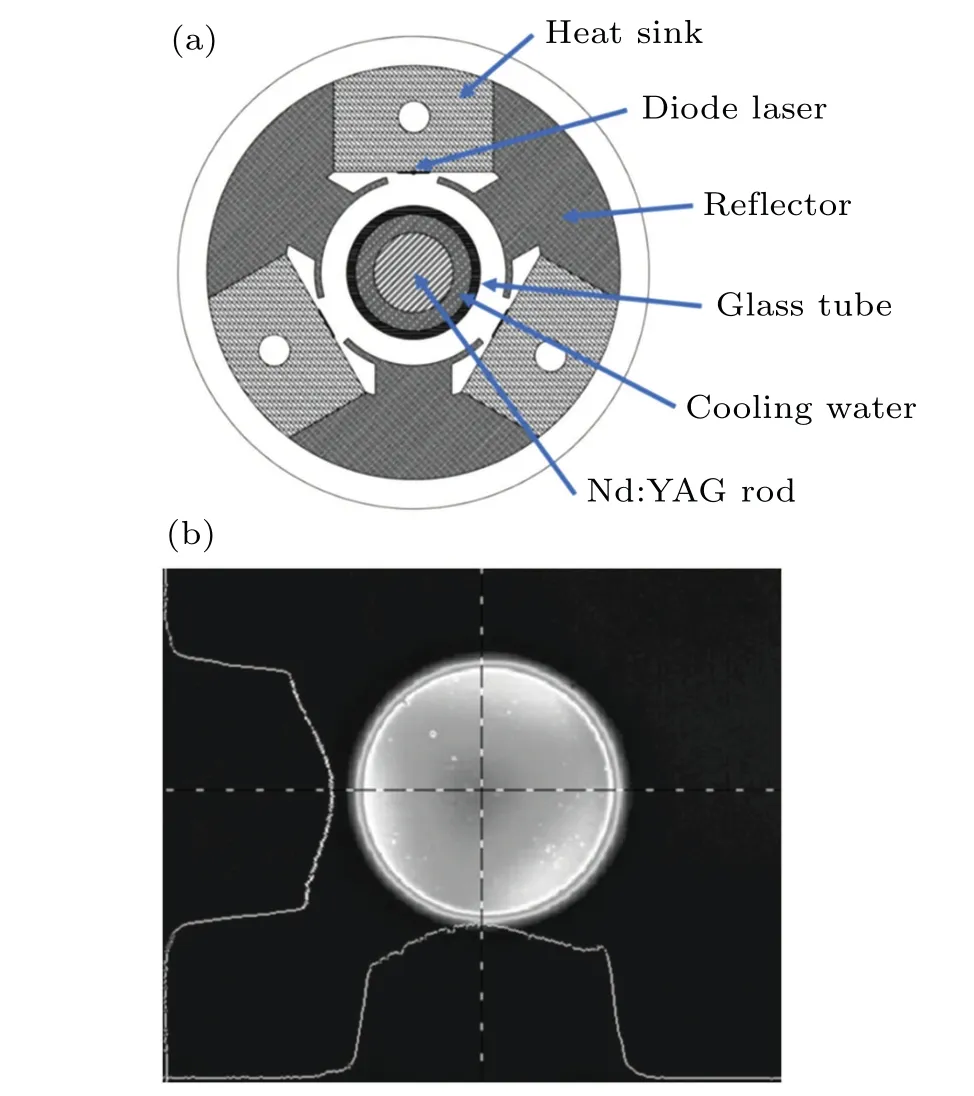
Fig.1. (a)Schematic diagram of the side-pumped module and(b)fluorescence distribution of the Nd:YAG rod.
The cross section schematic configuration of homemade laser diode(LD)side-pumped Nd:YAG laser module is illustrated in Fig. 1(a). The rod Nd:YAG crystal is doped of 0.6-at.% Nd3+with a diameter of 3 mm and length of 82 mm,and the two end facets are coated with antire-reflective film at 1064 nm. The Nd:YAG rod is surrounded by a diffusive reflector and side-pumped by three-fold symmetrically QCW 808-nm LD arrays. The diode bars operate at an adjustable pump pulse duration from 150 μs to 1000 μs with 800-Hz to 120-Hz repetition rate while the duty cycle remains 12%constant. The diffusive reflector is made of polished brass coated with gold to reflect the unabsorbed pumping light back into the crystal,where the absorption efficiency of the Nd:YAG rod is estimated to be as high as 95%. The LD arrays and Nd:YAG rod are cooled to 25°C with temperature precision of±0.1°by deionized water flowing in the heat sink and glass tube,in order to match the pump radiation wavelength of LD and the 808.5-nm absorption spectrum of Nd:YAG. The fluorescence distribution of the side-pumped module is measured at the rod end with a CCD,as shown in Fig.1(b),indicating the uniform gain distribution in the Nd:YAG rod. This above beam coupling method not only achieves efficient pumping for high output power,but also produces a uniform pump light distribution for good beam quality. A compact flat–flat cavity is utilized to investigate the average laser output powerversusthe pump pulse characteristics, as shown in Fig. 2. The mirror M1 is coated with high reflectance at 1064 nm,and the mirror M2 is an output coupler with a transmission of 40%at 1064 nm. The thermal effect of the Nd:YAG laser rod can affect laser performance seriously, and the corresponding thermal focal length is carefully measured by changing the distanceLbetween LH and M2.
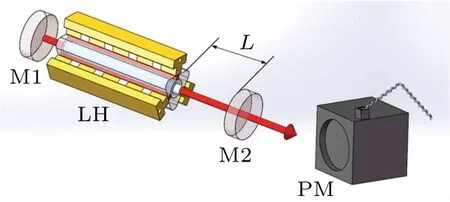
Fig. 2. Schematic diagram of laser resonator and the thermal focal measurement. LH: laser module; M1: high reflector; M2: output coupler; L:distance between LH and M2;PM:power meter.
3. Theoretical model
For practical solid-state lasers,the spontaneously emitted photon could be at any position and any direction inside the laser rod. Without ASE, the differential equation governing the population inversion densitynof laser rod is given by[17]

wheren0is the total number of atoms density of laser rod,φis the photon density in the laser cavity,σis the stimulated emission cross section of laser rod,cis the speed of the photon in vacuum,τfis the fluorescence lifetime of the upper laser manifold.Wp=βPp/Dchvpn0V0is the pumping rate, whereβdenotes the conversion efficiency including absorption and pump quantum efficiencies,Ppis the pump power,his the Planck constant,vpis the pump laser frequency,Dcis the duty cycle of the pump pulse,V0is the volume of active medium.
ASE will cause the large loss of the population density of the upper laser manifold,which has been considered as an unwanted parasitic effect.[18,19]Each spontaneously emitted photon is amplified by a factor of exp(σns), wheresis the path length of the spontaneously emitted photon in the laser rod,and then the population density of ASE photon with any frequencyvcan be written by[20]For a short laser resonator, the decay time for the photons is defined byτc=(2l/c)[2αl-ln(1-T)], whereαis the loss coefficient,Tis the transmission of output coupler,andlis the length of laser rod.nris the refractive index of the laser rod.
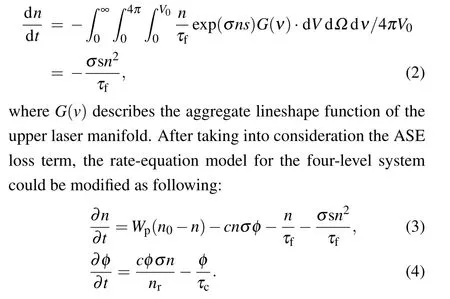
For the Nd:YAG laser system, the average output powerPocould be expressed as

whereEois the energy of single laser pulse,Ris the pulse repetition rate,Ais the area of output laser,hνlis the output laser photon energy,tpis the pump pulse duration.The average laser output power and optical-to-optical conversion efficiency versus the pump pulse duration are simulated by solving the coupled Eqs.(3)–(5)with the fourth-order Rounge–Kutta method.The following parameters used in the theoretical calculation is listed in Table 1.
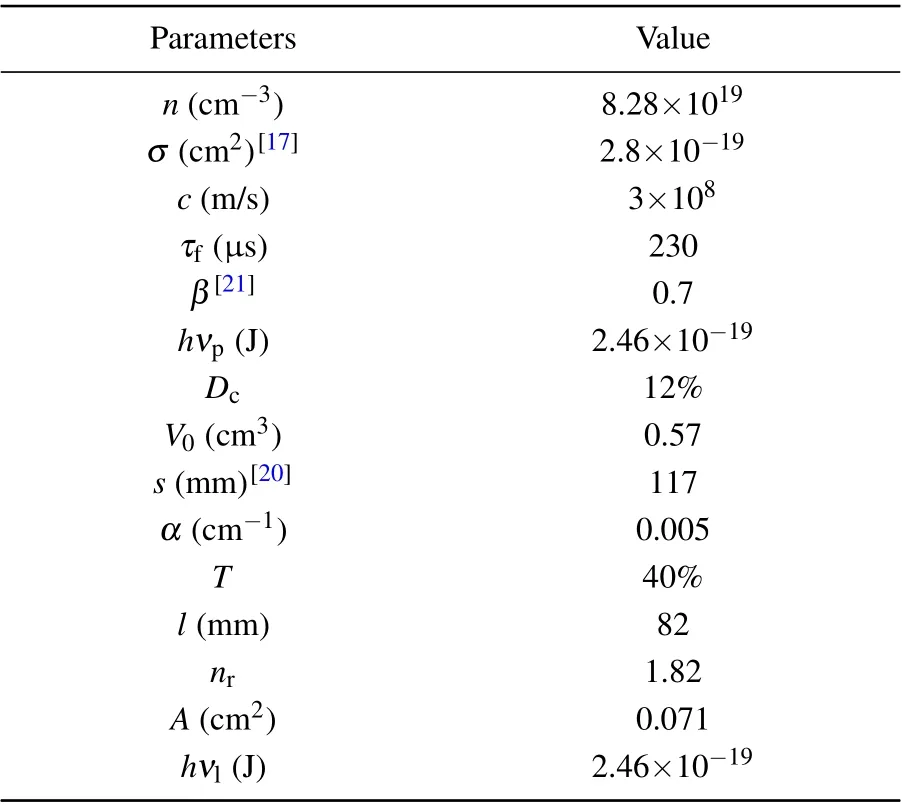
Table 1. Parameters for the laser cavity and Nd:YAG crystal.
For a QCW pulsed laser with a fixed duty cycle, it will not change the laser peak power for adjusting the ration of the repetition rate and pulse duration. Without regard to the imperative laser building up timetb, the optical-to-optical conversion efficiency can be given byη0=Po/(Pp-Pb), wherePbis the pumping power wasted by building the laser pulse.If the building up time of laser oscillation is not negligible,the relationship between the conversion efficiencyηand the pumping pulse durationtpcan be described as

we can see that the conversion efficiency has the positive proportion with the pump duration. Astpis usually a constant value,the saturation phenomenon will appear with further increasing the pump pulse duration.
4. Results and discussion
Under different pump pulse duration, the average output power as a function of the LD pump power is shown in Fig.3.The output power grows approximately linearly with the incident pump power from 67 W to 146 W. At the pump power of 146 W, the maximum output powers are measured to be 65.1 W, 69.4 W, 71.3 W, 73.6 W, 76.7 W, 78.4 W, 79.2 W,80.7 W, 81.2 W for 150 μs, 200 μs, 240 μs, 300 μs, 400 μs,500 μs, 600 μs, 800 μs, 1000 μs, respectively. The corresponding power increment is as high as 24.7% for the pump pulse duration from 150 μs to 1000 μs. The output energy does not show any roll-over effect up to the maximum pump energy, indicating that higher output can be achieved with higher pump energy. The compact laser resonator operates at multi transversal modes,and the power stability for each case is measured to be less than 0.5%within 30 min.
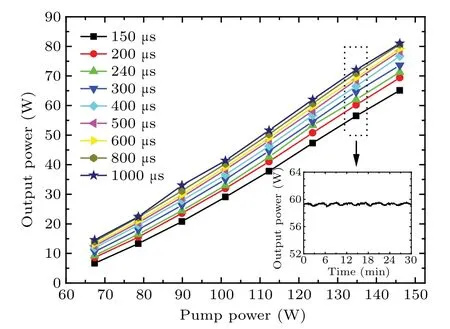
Fig.3. Average output power variation with input pump power for different pump pulse durations. The inset shows the power stability for each case.
The pulse temporal characteristics of the laser is monitored by the fast photodiode detector(Thorlabs Inc. DET200,rise time<25 ns) connected to a 4-GHz bandwidth digital oscilloscope (Tektronix DPO70404). At the pump power of 146 W,figure 4 shows the laser pulse trains of 800 Hz,150 μs;600 Hz, 200 μs; 400 Hz, 300 μs; and 200 Hz, 600 μs. The pulse duration of single pulse temporal profile is measured to be 130 μs,180 μs,280 μs,and 580 μs,respectively,which is less 25 μs than pulse duration of the pumping source,including the laser building up time of~20 μs,the pulse rising time of~0.5 μs, and the fall time of~4.5 μs. In unit time, the wasted pumping time for the oscillating laser is 16 ms,12 ms,8 ms, and 4 ms for 800 Hz, 600 Hz, 400 Hz, and 200 Hz,respectively.
The optical-to-optical conversion efficiency of QCW Nd:YAG laserversusthe pump pulse duration is shown in Fig. 5, and the measured conversion efficiency is 44.6%,47.5%, 48.8%, 50.4%, 52.5%, 53.7%, 54.7%, 55.3%, and 55.6%for the pump pulse duration of 150 μs,200 μs,240 μs,300 μs,400 μs,500 μs,600 μs,800 μs,and 1000 μs,respectively. Based on the laser theoretical model described previously, the simulated results of the conversion efficiency are plotted in Fig.5,using the red curve for that without ASE and the black curve for that with the ASE.It can be seen the theoretical result taking the ASE into consideration is in accordance with the experimental data. The conversion efficiency shows a significant improvement with increasing the pump pulse duration that decreases the ratio of the pulse buildup time to the pulse duration.Because of the smaller and smaller ratio,it tends to saturation for longer pump pulse duration>800 μs,which is also in excellent agreement with the green dot curve based on Eq.(6).
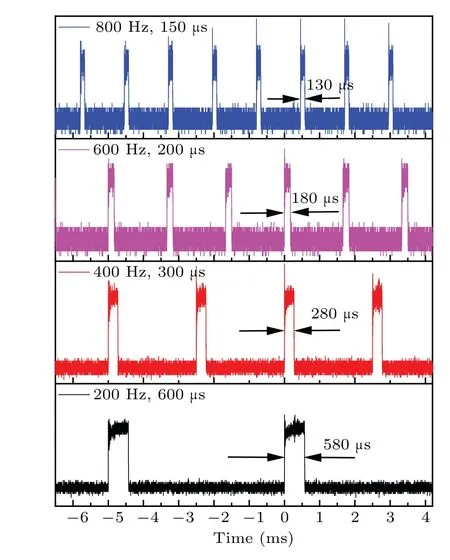
Fig.4. Observed oscilloscope traces of Nd:YAG laser pulse.

Fig. 5. Measured and simulated results of conversion efficiency as a function of pump pulse duration for pump power of 146 W and duty cycle of 12%: the red curve is the simulation without ASE, the black curve is the simulation with ASE,the blue dots are the measurement,and the green dot curve is the fitting with modified equation(6).
Figure 6 gives the effect of the pump pulse duration on the thermal focal length of the Nd:YAG laser rod, and the thermal focal length shorten slightly with increasing the pump pulse duration,particularly noticeable for higher power pumping. At a pump power of 120 W, the measured thermal focal length is approximately 710 mm and 697 mm for 200-μs pulse duration and 1000-μs pulse duration. At a pump power of 190 W, the corresponding thermal focal length reduces gradually from 440 mm to 405 mm. For a high power solid-state QCW laser with long pulse duration,the serious heat inside the laser rod could not be effectively carried away by the flowing water. This result will be conducive to optimizing the design of highly efficient QCW pulsed Nd:YAG lasers.
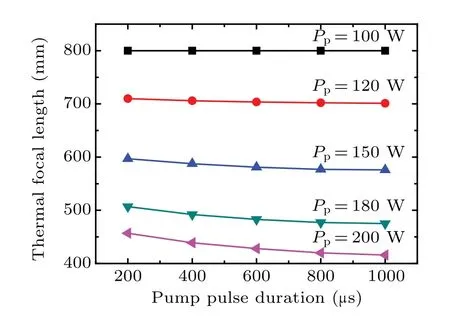
Fig. 6. Thermal focal length versus pump pulse duration under different pump powers.
5. Conclusion
In summary, the analytical and experimental studies on the influence of the pump pulse characteristics on output power of QCW laser are reported in details. In a proof-ofprinciple experiment,the laser output power expresses a 24%enhancement when the pump pulse duration increases from 150 μs to 1000 μs, due to the fact of decreasing the ratio of pulse build-up time to the pump pulse duration. However,the conversion efficiency tends to saturation and the thermal focal length is shorter for longer pump pulse duration. And,the theoretical analysis result with ASE effect is quite coincident with the experimental data.
Acknowledgements
Project supported by the National Key Research and Development Program of China(Grant No.2016YFB0402103),the Knowledge Innovation Program of the Chinese Academy of Sciences (Grant No. GJJSTD20180004), and the Fund of Technical Institute of Physics and Chemistry, Chinese Academy of Sciences(Grant No.Y8A9021H11).
杂志排行
Chinese Physics B的其它文章
- Erratum to“Boundary layer flow and heat transfer of a Casson fluid past a symmetric porous wedge with surface heat flux”
- Erratum to“Accurate GW0 band gaps and their phonon-induced renormalization in solids”
- A novel method for identifying influential nodes in complex networks based on gravity model
- Voter model on adaptive networks
- A novel car-following model by sharing cooperative information transmission delayed effect under V2X environment and its additional energy consumption
- GeSn(0.524 eV)single-junction thermophotovoltaic cells based on the device transport model
